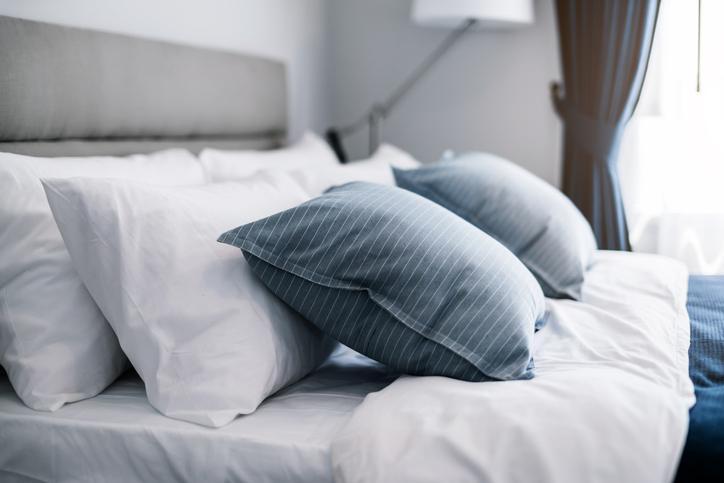Pillow Showdown: Latex vs Memory Foam Pillow



Memory foam is commonly made from “viscoelastic” polyurethane foam, which is commonly found in sofas, mattresses, insulation and spray foam. Interestingly, it was first created by NASA for use in spaceship seats and seatbelts owing to it's ability to absorb shock and relieve pressure.
It gets its name from it's inherent ability to change shape under pressure but then quickly return to its original shape when the pressure is gone.
Although it can initially feel firm to the touch, memory foam softens in response to body heat and can come in 3 different forms. They are traditional, open cell and gel infused memory foam. You can read more about this in our recent post covering what a memory foam pillow is.
It is widely agreed that foam pillows tend to last between 2-3 years.
With regular cleaning and care they may last longer.

At it's inception, latex was natural foam developed with sap taken from the hevea-brasilienis rubber tree. The uniquely useful sap was made into a foam that possessed an exorbitant amount of air bubbles which could lay claim to the soft and bouncy texture of the foam.
Fast forward to today and the natural nature of latex has been somewhat accosted and overtaken by several forms of synthetic latex.
Synthetic latex foam is predominately made from Styrene-Butadiene Rubber (SBR) which feels very similar to natural latex but many people in the foam world highlight it doesn't possess the same durability as it's natural latex counterpart.
A latex foam pillow can last anywhere from 5-10 years, depending on how well it is maintained.
In saying that, for the purpose of structural integrity and cleanliness, we would recommend replacing your latex foam pillow before you've had it for five+ years!

Before we get into the nitty gritty and 'potentially' crown a champion, let us first preface that your showdown champion will almost certainly hinge on your unique sleep preferences!
For example, latex pillows tend to be bouncy and quick to react to pressure (i.e. your head), while a foam pillow takes a little longer to contour to your head and is also firmer.
Let's explore the pros and cons of both.

As one of the most durable pillow materials on the market, latex foam pillows offer longevity alongside great temperature regulation.
Latex pillows offer a range of benefits with one of the biggest ones being their innate ability to provide a cooler sleep than memory foam.
A latex pillow is also incredibly responsive to your head's pressure, providing a strong ability to bounce back to natural form when relieved of pressure.
Moreover, with eco-friendly characteristics, purchasing a latex pillow is an ode to the environment and sustainable living, especially if it's natural latex!Finally, as mentioned earlier, a latex pillow will tend to last longer than a pillow made from memory foam.
When comparing latex vs memory foam, latex tends to be heavier than memory foam and therefore more challenging to move. Obviously this is not really an issue with pillows, but if you're considering a latex foam mattress for example, it very much becomes a factor!
When it comes to pressure relief, latex comes in second to memory foam, but not only that, the material also tends to be more expensive than memory foam.
Additionally, if you're a light sleeper latex might give you some headaches because it tends to be a little noisy.
But what about foam pillows?


The cat's out of the bag a little bit here because we've already mentioned memory foam is superior to latex when it comes to pressure relief, but what else, if any?
You guessed it! For those with achy joints, arthritis and neck pain, a memory foam pillow for you! Additionally, for you light sleepers out there, you can rest easy knowing your foam pillow won't be the cause of any late night interruptions.
Do you happen to move around a lot in your sleep? Perhaps your partner does? Either way, if motion isolation is a key factor in your choice of bedding than you're going to be a fan of memory foam!
Lastly but by no means any less important, memory foam is great at softening to your body after an initial firmness, gently moulding to your body to help with correct posture during sleep.It all sounds pretty good yeah?
Wait just a sec, memory foam does have some drawbacks.
If you struggle with heat during your slumber than latex might be a better option because memory foam does tend to trap heat throughout the night.
Also, in direct contrast to latex, memory foam has a tendency to sag over time which explains it's shorter life-span compared to latex foam.
Memory foam also lacks the same amount of bounce back that latex can provide, so if this is big on your list of needs, latex might be better for you.

Much like everything we've already discussed, it's really up to your particular sleep preferences and the extent of your back pain.
Both memory foam and latex pillows offer back support and pressure relief. Just remember:
Remember, whatever you choose, a pillow is only as good as the pillowcase around it!

So there you have it!
The great pillow showdown has reached an impasse. We hope this journal has helped you better decipher which material would be best suited to your knees!
If it has and you are indeed in the market for new pillows, we encourage you to check out our very own memory foam bamboo pillow.
And if you need some guidance on what to do with your old unwanted pillows, learn how to dispose of pillows in Australia.
https://www.nasa.gov/offices/ipp/home/myth_foam.html#:~:text=Memory%20foam%2C%20also%20known%20as,the%20popular%20mattresses%20and%20pillows.